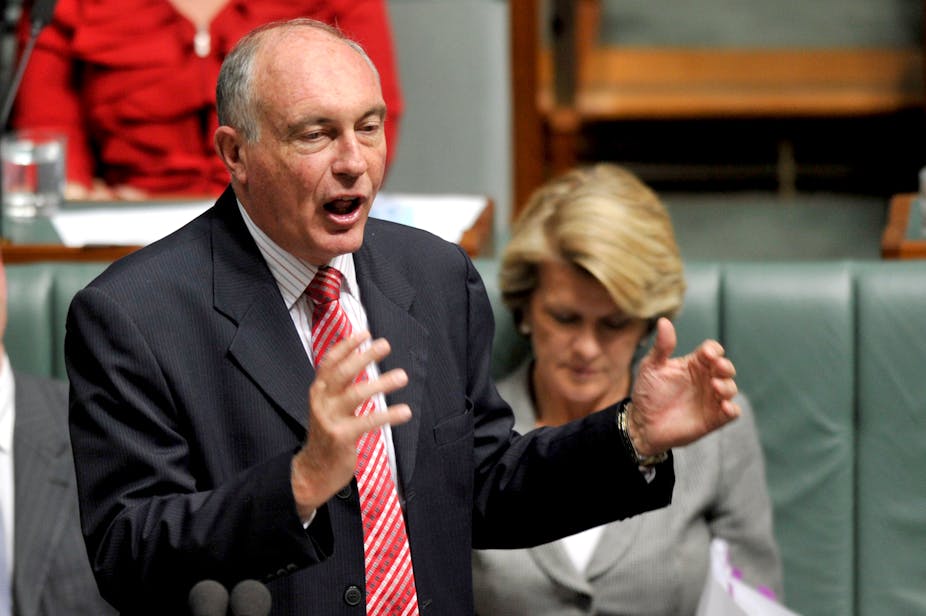Coverage of NSW state politics in the metropolitan media understandably focused on the devastating losses suffered in the 2011 election by Labor in its heartland areas, of Western and Southern Sydney, the Hunter and the Illawarra.
This unprecedented success of the NSW Liberal Party, led by Barry O’Farrell, has somewhat overshadowed the similar fortune shared by its Coalition partner, the NSW National Party.
It recaptured its traditional heartland areas: the North Coast, the Western districts and the Riverina. The Nationals now have their best proportional representation in the NSW Parliament since 1938, with significant implications for policy in the new Government, and potentially for national politics.
The increased numbers of National MPs (from 13 to 18 seats, on a 12.5% primary vote, an increase of 2.5) had raised their hopes for greater representation in the new Government’s Ministry. However, the huge increase in the number of Liberal MPs (51, leaving Labor with only 20) meant the Nationals lost a minister (Melinda Pavey MLC, now Parliamentary Secretary for regional health), down from 8 to 7, which is sure to be a niggling disappointment.
Nevertheless, Deputy Premier Andrew Stoner stated that greater attention, and presumably public funding and provision of services, will be directed towards rural and regional NSW, which has higher average rates of social and economic disadvantage.
Extra funding for the long-neglected Pacific Highway has already been announced, with Coffs Harbour MLA Andrew Fraser appointed Deputy Speaker of the Legislative Assembly, which has further mollified the Nationals’ loss of a ministry.
Allocation of portfolios in the ministry reflects the renewed prominence of the Nationals. As Deputy Premier and National Party leader, Stoner had his pick, and selected one of the new expanded “mega ministries”: Trade & Investment, Regional Infrastructure & Services; Duncan Gay (Leader of the Nationals and the Government in the Legislative Council) has Roads and Ports, roads being a traditional priority for the Nationals; Adrian Picolli (Deputy Nationals Leader) has Education, a senior portfolio, and a major concern in rural areas; Don Page - Local Government and the North Coast, again emphasising the regions; George Souris - Tourism, Major Events, Hospitality and Racing, the Arts, areas non-metropolitan NSW would like to see promoted more in their favour; Katrina Hodgkinson (one of five women in the Cabinet; down from 7 in the previous ALP ministry) – Primary Industries, and Small Business, core traditional areas of interest for the Nationals; and Kevin Humphries - Minister for Mental Health, Healthy Lifestyles, and Minister for Western NSW – again reflecting representation for the regions.
The resurgence of the Nationals was at the expense of two regional rivals: “Country” Labor, now likely to disappear as a political brand, tainted by NSW Labor as a whole (losing the seats of Bathurst and Monaro); and the rural Independents.
The seats of Dubbo, Tamworth, and Port Macquarie had long been eyed by the Nationals for reclamation, and the defeat of independent MPs in those State seats has been well noted by the Federal Opposition.
The NSW Nationals have been participating in the Federal Opposition’s anti-carbon tax campaign, especially on the North Coast, as a precursor for the desired reclamation of the Federal Independents’ seats of Lyne and New England, held by Rob Oakeshott and Tony Windsor.
In defence of the NSW Independents, Windsor has claimed they were out-spent by the Nationals in the NSW election campaign, potentially exceeding legally allowed spending caps on political advertising. Windsor has pointed out that 53% of primary votes across the two seats of Northern Tablelands and Tamworth (overlapping his Federal seat) still went to independents, and former speaker Richard Torbay, managed to keep his seat of Northern Tablelands, despite a 10% swing against him.
In the Legislative Council, 4 Nationals, 7 Liberals, 3 Greens, and one each from the Shooters and Fishers Party (SFP) and Christian Democrat Party were elected to the Upper House, resulting in the current total of: 19 Coalition MLCs, 14 Labor, 5 Greens, and 2 each from the SFP and CDP.
Premier O’Farrell has denied his Government will make deals with the Upper House crossbench parties. However, in order to get legislation through, the Coalition is already faced with potential compromises, as was the previous Labor Government.
CDP leader Fred Nile has already confronted the NSW Government over ethics classes in public schools, only just backing down on a threat to block legislation on changes to industrial relations.
An ongoing dilemma remains for the Nationals, of being constrained by Coalition policy, which can potentially go against rural and regional interests.
Such contradictory positions include opposing the NBN (which would greatly improve broadband to the regions); and a carbon price (which has exemptions for agriculture and fuel, under the Labor Government’s plan).
The increasing divisions between farmers and the mining industry over coal seam gas mining is also proving to be a controversial dilemma, pitting two key traditional support groups for the Nationals against each other. With the Coalition maintaining a huge lead in the opinion polls though, the Nationals will be hoping to replicate their NSW success at the next Federal election in 2013.

